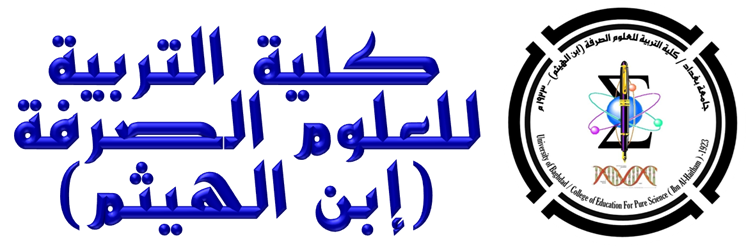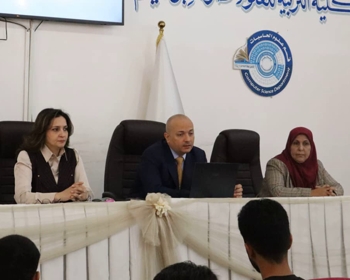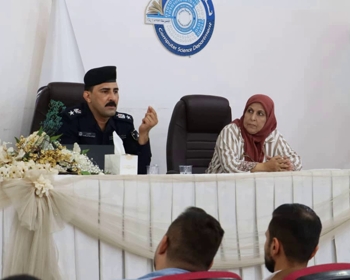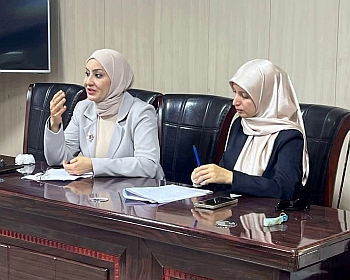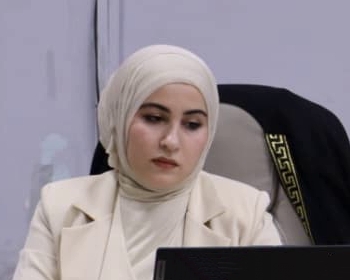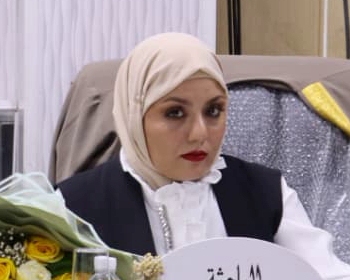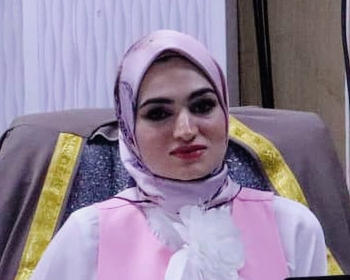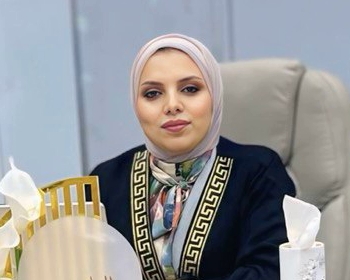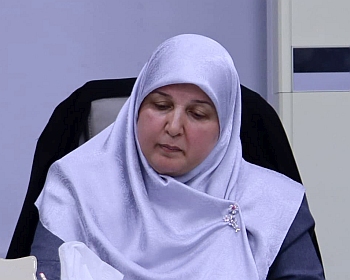ناقش قسم علوم الحياة في كلية التربية للعلوم الصرفة (ابن الهيثم) رسالة الماجستير الموسومة ” أثر تكنولوجيا الواقع المعزز في تحصيل طالبات الصف الرابع العلمي في مادة علم الأحياء وعمليات التعلم لديهن ” للطالبة ” هبة كريم عبد الله ” التي انجزتها باشراف التدريسي في القسم ” أ.م.د. سالم عبد الله سلمان ” ونوقشت من قبل أعضاء لجنة المناقشة المبينة أسمائهم في ما يأتي :
أ.د. حيدر مسير حمد الله – رئيسا ً
أ.د. قحطان فضل راهي – عضوا ً
أ.م.د. نسرين حمزة عباس – عضوا ً
أ.م.د. سالم عبد الله سلمان – عضوا ً ومشرفا ً
ويهدف البحث التعرف على:
أثر تكنولوجيا الواقع المعزز في تحصيل طالبات الصف الرابع العلمي في مادة علم الأحياء وعمليات العلم لديهن.
لغرض التحقق من هدف البحث صاغت الباحثة الفرضيتين الصفريتين الآتيتين:
لا يوجد فرق ذا دلالة إحصائية عند مستوى (0.05) بين متوسط درجات طالبات المجموعة التجريبية اللاتي يدرسن وفقا ً لتكنولوجيا الواقع المعزز ومتوسط درجات طالبات المجموعة الضابطة اللاتي يدرسن وفقا ً للطريقة الاعتيادية في الاختبار التحصيلي.
لا يوجد فرق ذا دلالة إحصائية عند مستوى (0.05) بين متوسط درجات طالبات المجموعة التجريبية اللاتي يدرسن وفقا ً لتكنولوجيا الواقع المعزز ومتوسط درجات طالبات المجموعة الضابطة اللاتي يدرسن وفقا ً للطريقة الاعتيادية في اختبار عمليات العلم.
لتحقيق هدف البحث استعملت الباحثة التصميم التجريبي ذا الضبط الجزئي كما تحدد البحث الحالي بطالبات الصف الرابع العلمي في المدارس الثانوية والاعدادية النهارية الحكومية التابعة للمديرية العامة لتربية بغداد / الكرخ الأولى للعام الدراسي (2021 – 2022) واختيرت اعدادية محمد مهدي البصير للبنات بصورة قصدية لتكون طالباتها عينة البحث ثم اجري اختيار شعبتين من الصف الرابع العلمي بصورة عشوائية لتمثل احداهما المجموعة التجريبية والأخرى المجموعة الضابطة وبلغت عينة البحث (60) طالبة بواقع (30) طالبة في المجموعة التجريبية و(30) طالبة في المجموعة الضابطة.
تم اجراء التكافؤ بين أفراد مجموعتي البحث في متغيرات (العمر الزمني، واختبار الذكاء، ودرجات اختبار المعلومات الأحيائية السابقة، ودرجات مادة علم الأحياء في اختبار بداية الفصل الأول) كما حددت المادة العلمية بالفصول الخمسة الأولى من كتاب علم الأحياء المقرر الذي تم تدريسه للعام الدراسي (2021 – 2022).
صيغت الأغراض السلوكية لهذه الفصول التي بلغ عددها (176) غرضا ً سلوكيا ً ممثلة للمستويات الستة لتصنيف بلوم في المجال المعرفي (تذكر واستيعاب وتطبيق وتحليل وتركيب وتقويم) وفقا ً لعدد الحصص المقترحة لكل فصل ثم اعدت الخطط التدريسية لمجموعتي البحث وبلغ عددها (24) خطة لكل مجموعة وقد درست الباحثة المجموعتين بنفسها خلال مدة التجربة التي استمرت (8) أسابيع من الفصل الأول للعام الدراسي (2021 – 2022).
تم إعداد اداتا البحث الاختبار التحصيلي واختبار عمليات العلم حيث أعدت الباحثة اختبارا ً تحصيليا ً للفصول الخمسة الأولى من كتاب علم الأحياء للصف الرابع العلمي وتألف الاختبار بصورته النهائية من (50) فقرة اختبارية موضوعية من نوع الاختيار من متعدد ذي أربعة بدائل وتم التحقق من الصدق الظاهري وصدق المحتوى للأداة أما اختبار عمليات العلم فقد تألف بصورته النهائية من (40) فقرة اختبارية من النوع الاختيار من متعدد ذي أربعة بدائل وهذه العمليات هي: الملاحظة، والتصنيف، والاستدلال، والاستنتاج، والتنبؤ، والتعريف الاجرائي، وضبط المتغيرات، والتفسير إذ تم التحقق من الصدق الظاهري للأداة وتم حساب الخصائص السايكومترية لكلا الاختبارين إذ تم تحميل البيانات على برنامج (SPSS – V22) ومعالجتها إحصائيا ً وباعتماد (t – test) لعينتين مستقلتين متساويتين ومعادلة كيودر ريتشارد – 20 وطريقة التجزئة النصفية ومعامل ارتباط بيرسون والانحراف المعياري ومعامل الصعوبة ومعامل التمييز للفقرات وفعالية البدائل للفقرات الموضوعية.
وبعد انتهاء التجربة تم تطبيق الأداتين على مجموعتي البحث ثم صححت إجابات الطالبات وتمت معالجتها احصائيا ً إذ اظهرت النتائج الأتية:
يوجد فرق ذا دلالة إحصائية عند مستوى (0.05) بين متوسط درجات طالبات المجموعة التجريبية اللاتي يدرسن وفقا ً لتكنولوجيا الواقع المعزز ومتوسط درجات طالبات المجموعة الضابطة اللاتي يدرسن وفقا ً للطريقة الاعتيادية في الاختبار التحصيلي لصالح المجموعة التجريبية في الاختبار التحصيلي وبحجم أثر كبير للمتغير المستقل بلغ (1.15).
يوجد فرق ذا دلالة إحصائية عند مستوى (0.05) بين متوسط درجات طالبات المجموعة التجريبية اللاتي يدرسن وفقا ً لتكنولوجيا الواقع المعزز ومتوسط درجات طالبات المجموعة الضابطة اللاتي يدرسن وفقا ً للطريقة الاعتيادية في اختبار عمليات العلم لصالح المجموعة التجريبية في اختبار عمليات العلم لديهن وبحجم أثر للمتغير المستقل بلغ (0.96).
تم وضع عدد من الاستنتاجات والتوصيات والمقترحات ومن أبرز ما توصل إليه البحث من توصيات:
.1 تطبيق تكنولوجيا الواقع المعزز والافادة منها كتطبيقات ناجحة في تحقيق أهداف العملية التعليمية وتجهيز المدارس بقاعات تعليمية مزودة بكافة الأجهزة والشاشات التي تمكن المدرس من استخدام تكنولوجيا الواقع المعزز في تدريس المواد.
.2 يؤدي استخدام تكنولوجيا الواقع المعزز إلى تفاعل كبير بين الطالبات في العملية التعليمية وتزيد من دافعية الطالبات في التعلم وتشعر الطالبات بالسعادة عند استخدام هذه التقنيات في الشرح مما يؤدي إلى تفاعل أكبر من قبل الطالبات وهذا يكون له الأثر في الاحتفاظ بالمعلومات لفترات أطول.
استكمالا ً لموضوع البحث تقترح الباحثة ما يلي:
إقامة الدورات التدريبية للمدرسات في جميع المراحل حول استخدام تقنيات تكنولوجيا الواقع المعزز وطرق تصميمها واعدادها.
تدريب مدرسي ومدرسات الأحياء قبل الخدمة واثناءها على أدوات تكنولوجيا التعليم الحديثة وتطبيقات الواقع المعزز بشكل خاص وتأكيد ضرورة الاستفادة منها في تعليم الاحياء وتعلمها في ضوء نظرية تربوية بما يضمن الاستفادة القصوى من هذه التكنولوجيا.
تشجيع المدرسات من قبل المشرفين الاختصاص على استخدام تكنولوجيا الواقع المعزز وطرائق التدريس التي تساعد الطالبات داخل المختبر لدورها الفاعل في تنمية عمليات العلم الأساسية والتكاملية.
تطوير وتحديث البنية التحتية والدعم الفني في المدارس للاستفادة من التكنولوجيا الحديثة وتوظيف الواقع المعزز في التعليم والتعلم وتوفير البرمجيات اللازمة لذلك.
توجيه مدرسي الأحياء لإعداد اختبارات عمليات العلم المشابهة للأداة المستخدمة في البحث وتعويد الطلبة على الاستفسار والتجريب عند الحصول على المعلومات بدلاً من تلقيها من خلال الحفظ .
The impact of Augmented Reality Technology on the Achievement of Fourth-grade Science Students in Biology and their
Science Processes
By Hiba K.Abdulla
Supervised by Asst.prof.Dr. Salim A.Salman
Abstract
The Aim of the Research is to Identify
The Effect of augmented reality technology on the achievement of fourth – grade students in biology and their science processes
In order to verify the objective of the research, the researcher formulated the following two hypotheses
. There is no statistically significant difference at the level (0.05) between the average scores of the experimental group students who study according to augmented reality technology and the scores of the control group students who study according to the usual method in the achievement test.
. There is no statistically significant difference at the level (0.05) between the average scores of the experimental group students who study according to augmented reality technology and the scores of the control group students who study according to the usual method in the science processes test.
To achieve the Aim of the research, the researcher used the experimental design a partial control, as well as current research was Identified by choosing scientific fourth-grade students in government diurnal secondary schools which obey to Baghdad education directorate / the first Karkh of studious year (2021-2022). The research was then randomly chosen to represent two divisions of the scientific fourth class, one of them represent the experimental group and another the controlled group. The research sample amounted to (60) female students, with (30) female students in the experimental group and (30) female students in the controlled group
interpretation. The behavioral objectives of these chapters, which numbered (176) were formulated, represented to six levels of Bloom’s Taxonomy in the cognitive domain (remember, absorbing, application, analysis, structure and evaluation) according to the number of suggested lessons for each chapter. For each group, where the researcher taught the two groups herself during the experiment period, which lasted (8) weeks from the first semester of the academic year 2021-2022
The research tools were prepared, the achievement test and the science process test, where the researcher prepared an achievement test for the first five chapters of the biology book for the fourth scientific grade .The research tools were prepared, the achievement test and the science process test, where the researcher prepared an achievement test for the first five chapters of the biology book for the fourth scientific class. The test in its final form consisted of (50) objective test items of the type of multiple choice with four alternatives. And the content validity of the tool. As for the science operations test, it consisted in its final form of (40) A test paragraph of the multiple-choice type with four alternatives, and these operations are: observation, classification, inference, conclusion, prediction, procedural definition, controlling variables, and interpretation. (SPSS-V22) and statistically treated using (t-test) for two unequal independent samples, Kewder-Richard equation-20, half-segmentation method, Pearson correlation coefficient, standard deviation, difficulty coefficient, discrimination coefficient for items, and the effectiveness of alternatives for objective items.
After the end of the experiment, the two tools were applied to the two research groups, then the students’ answers were corrected and they were treated statistically, as the following results showed
- There is a statistically significant difference at the level (0.05) between the average scores of the experimental group students who study according to augmented reality technology and the scores of the control group students who study according to the usual method in the achievement test in favor of the experimental group in the achievement test, with a large effect size for the independent variable amounting to
. (1.15)
- There is a statistically significant difference at the level (0.05) between the average scores of the experimental group students who study according to augmented reality technology and the scores of the control group students who study according to the usual method in the science operations test in favor of the experimental group in their science operations test and the size of the effect of the variable The independent score was (0.96).
– A number of conclusions, recommendations and proposals have been developed Among the most prominent recommendations of the research are: The application of augmented reality technology and benefiting from it as successful applications in achieving the goals of the educational process and equipping schools with educational halls equipped with all devices and screens that enable the teacher to use augmented reality technology in teaching subjects as well as The use of augmented reality technology leads to a great interaction between students in the educational process and increases the motivation of students to learn. Students feel happy when using these techniques in explanation, which leads to greater interaction by students and this, has the effect of retaining information for longer periods.
Recommendations
As a complement to the research topic, the researcher suggests the following:
. Holding training courses for female teachers at all levels on the use of augmented reality technologies and methods of designing and preparing them.
.Training biology teachers before and during service on the tools of modern educational technology and applications of augmented reality in particular, and confirming the need to benefit from them in teaching and learning biology in the light of an educational theory in order to ensure maximum benefit from this technology.
.Encouraging female teachers by specialized supervisors to use augmented reality technology and teaching methods that help students in the laboratory for their active role in developing basic and integrative science processes.
.Developing and modernizing the infrastructure and technical support in schools to take advantage of modern technology and employ augmented reality in teaching and learning and provide the necessary software for that.
.Directing biology teachers to prepare science operations tests similar to the tool used in research, and accustom students to inquiry and experimentation when obtaining information instead of receiving it through memorization and memorization.
